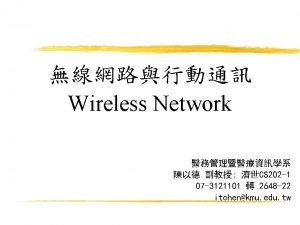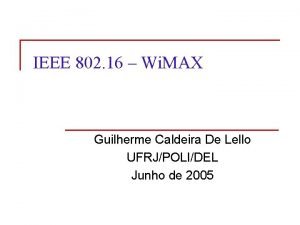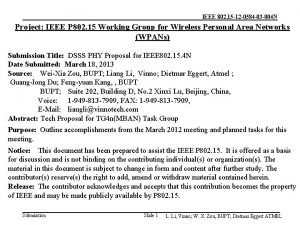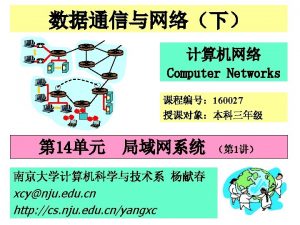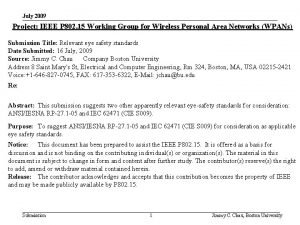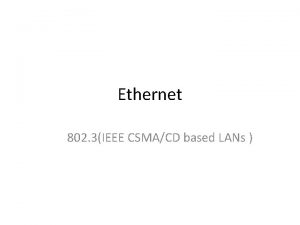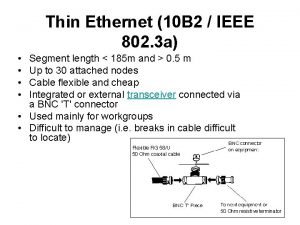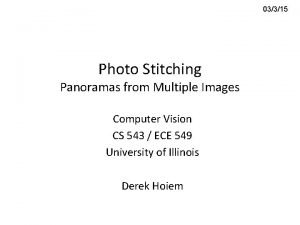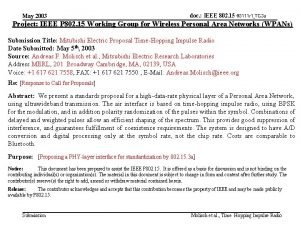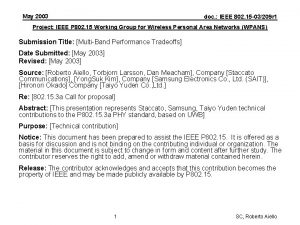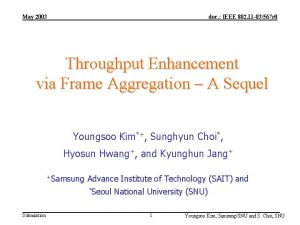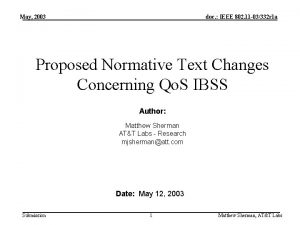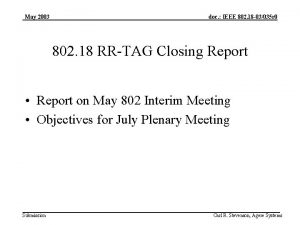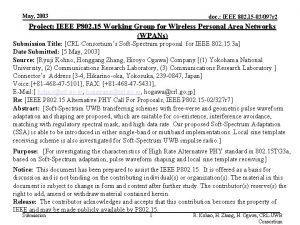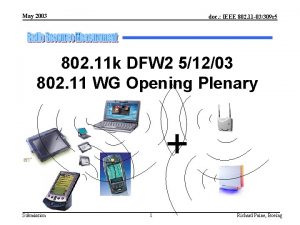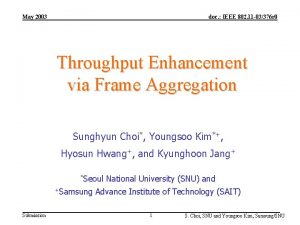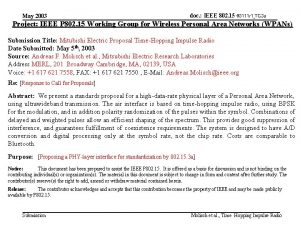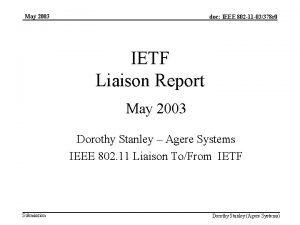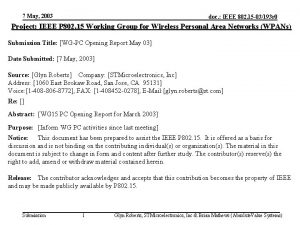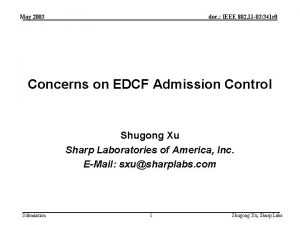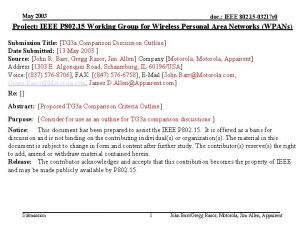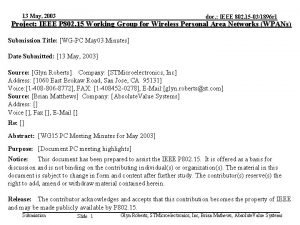May 2003 doc IEEE 802 11 03315 r



















- Slides: 19

May 2003 doc: IEEE 802. 11 -03/315 r 1 RCPI and PSNI: New PHY Measurements comparative measurements of receiver input and output to support network management Joe Kwak Inter. Digital Communications Corporation Submission 1 Joe Kwak, Inter. Digital

May 2003 doc: IEEE 802. 11 -03/315 r 1 Outline n n n Need for new PHY measurements RCPI and PSNI Relation to SNR in Demodulator Received Channel Power Indicator (RCPI) Definition Perceived Signal-to-Noise-plus-interference Indicator (PSNI) Definition PSNI Analysis: Relation to Eb. No, SNR and BER Motions to incorporate RCPI and PSNI Submission 2 Joe Kwak, Inter. Digital

May 2003 doc: IEEE 802. 11 -03/315 r 1 Need for New PHY Measurements n n n n RSSI is defined at antenna input connector but is not fully specified: no unit definitions, no performance requirements (accuracy, testability). Since so little about RSSI is specified, it must be assumed that widely variant implementations already exist. It is not possible to compare RSSIs from different STAs and perhaps not even from different channels/PHYs within same STA. RSSI may have limited use for evaluating AP options within a STA and within a given PHY, but not between PHYs. RSSI is rescaled between DSSS and OFDM PHYs. RSSI is clearly not useable by network management for handoff or load balancing. RSSI from one STA does not relate to RSSI from any other STA. In high interference environments, RSSI is not an adequate indicator of desired signal quality, since it indicates the sum of desired signal + noise + interference powers. Proposed RCPI provides quantized, objective input power measure (S+N+I). Proposed PSNI provides quantized, comparative measure of received signal quality [observed S/(N+I)] for all channels/rates and among all PHYs and between all STAs. Submission 3 Joe Kwak, Inter. Digital

May 2003 doc: IEEE 802. 11 -03/315 r 1 PHY Measurement Architecture AGC Radio front end A B A/D Demodulator and tracking loops (PHY specific) A: Total RF power, RF S/(N+I) from each AP (BB power constant by AGC) n FEC Decoder (optional) D Frame Check (CRC) E C&D: Bit Error Rate (BER) @each data rate from each AP E: Frame Error Rate (FER) @each data rate from each AP B: BB S/(N+I) from each AP n C RCPI measures total RF Power at antenna input connector A. PSNI measures observed S/(N+I) within demodulator but normalizes measurement for FER at E. Submission 4 Joe Kwak, Inter. Digital

May 2003 n doc: IEEE 802. 11 -03/315 r 1 Measure PHY Demod Input (power) and Output (QOS) Accurate S/(N+I) measurement at A is interesting but because RF/demod implementations vary widely, it cannot be used comparatively between STAs to evaluate delivered signal quality. n Accurate FER measurement at E is ideal quality measure, but cannot be measured frame by frame. FER can only be accurately measured over 100 s-1000 s of frames. Also, FERs are comparable only at same frame size and data rate. -80 dbm Good STA -80 dbm E (FER) A (d. Bm) -80 dbm 10 E-5 Med STA Marginal STA A (d. Bm) 10 E-4 -78 dbm 10 E-2 -75 dbm Submission 10 E-5 E (FER) Med STA Marginal STA 10 E-5 Signal at same subjective SNR Signal at same objective SNR Measure RCPI power at A. Good STA Measure PSNI quality in middle, but specify PSNI with FER at E. 5 Joe Kwak, Inter. Digital

May 2003 doc: IEEE 802. 11 -03/315 r 1 RCPI and PSNI Relation to SNR in Demodulator Received Channel Power Level d. Bm (S + N + I) Desired Signal Power d. Bm Required Min RSPL Level (RCPI at antenna connector) Total Modem Implementation Losses (TML) Operating Margin Observed Digital SNIR Ratio (PSNI in Theoretical SNR demodulator) for required BER Observed Analog SNIR Ratio FEC Decoder Loss, if any Input Demodulator Loss Analog Rx Amp Noise Figure + IM Distortion SNIR Ratio Channel Impairments (CI) o d. Bm Antenna Connector: Input Power Level (S+ N + I) d. Bm Thermal Input Noise Level (-100 d. Bm) Boltzman’s C (-198 d. Bm/Hz/K) Submission (fading + multipath + etc, = 0 in AWGN)) Interference Power at Input SNR Ratio Total Channel Condition Losses Temp = 290 K = 24. 6 d. B NBW = 22 MHz = 73. 4 d. B 6 Joe Kwak, Inter. Digital

May 2003 doc: IEEE 802. 11 -03/315 r 1 RCPI Concept: Measure Input Power n n n Specified like RSSI: 8 -bit unsigned value, monotonically increasing with increasing signal strength. RCPI shall be logarithmically scaled in d. B to measure total received power within defined channel bandwidth at the antenna connector. Includes power from desired signal, noise, and interference. RCPI values shall be quantified in d. Bm and accuracy shall be specified across entire RCPI range. The 221 RCPI levels shall range from -110 d. Bm to 0 d. Bm with 2 units per d. B. RCPI accuracy shall be +/- 5 d. B across the defined range, equivalent to accuracy specified by TGH for RPI histogram. RCPI may be used wherever RSSI is specified. Submission 7 Joe Kwak, Inter. Digital

May 2003 doc: IEEE 802. 11 -03/315 r 1 RCPI Normative Specification Text n n The RCPI indicator is a measure of the received RF power in the selected channel, measured at the antenna connector. This parameter shall be a measure by the PHY sublayer of the received RF power in the channel measured over the PLCP preamble and over the entire received frame. RCPI shall be a monotonically increasing, logarithmic function of the received power level defined in d. Bm. The allowed values for the Received Channel Power Indicator (RCPI) parameter shall be an 8 bit value in the range from 0 through 220, with indicated values rounded to the nearest 0. 5 d. B as follows: n 0: Power < -110 d. Bm n 1: Power = -109. 5 d. Bm n 2: Power = -109. 0 d. Bm and so on n 220: Power > -0 d. Bm n 221 -255: reserved Accuracy for each measurement shall be +/- 5 d. B. The measurement shall assume a receiver noise equivalent bandwidth of 22 MHz. Submission 8 Joe Kwak, Inter. Digital

May 2003 doc: IEEE 802. 11 -03/315 r 1 PSNI: Demodulator-specific, Post-processing Estimator of Observed S/(N+I) and BER/FER. n All digital demodulators use tracking loops and complex post-processing to demodulate received symbols. Many internal demodulator metrics are proportional to perceived S/(N+I). Examples: n n n n PSK: baseband phase jitter and received Error Vector Magnitude (EVM) DSSS: spreading code correlation quality OFDM: frequency tracking and channel tracking stability Demodulator internal metrics are available on a frame-by-frame basis. Demodulator metrics proportional to S/(N+I) are available at all data rates. Demodulator internal metrics may be calibrated with respect to actual FER performance to accurately indicate perceived or observed S/(N+I) in controlled environment with AWGN. Such demodulator internal metrics are fast estimators of S/(N+I) in both interference environments and interference-free (noise only) environments. TGK need not specify which demodulator metrics to use, but needs only to specify how the quantized PSNI indicator relates to S/(N+I) and FER Submission 9 Joe Kwak, Inter. Digital

May 2003 doc: IEEE 802. 11 -03/315 r 1 PSNI Concept: Measure Output Signal Quality n n n Specified like RSSI: 8 -bit unsigned value, monotonically increasing with increasing S/(N+I). PSNI shall be logarithmically scaled to perceived S/(N+I) which relates directly to FER performance. Specify PSNI output value for each data rate using FER points: first point to “anchor” indicator, additional points to quantize and scale indicator slope and range of values. Specify accuracy of PSNI in AWGN to be +/- 1. 66 d. B for all FER points. PSNI range shall span the lower 43 d. B portion of the operating range of S/(N+I) to cover high FERs at data rates from 1 to 54 Mbps. Submission 10 Joe Kwak, Inter. Digital

May 2003 doc: IEEE 802. 11 -03/315 r 1 PSNI Normative Specification Text n The PSNI indicator is a measure of the perceived, post-processing signal-to-noise-plusinterference (S/(N+I)) ratio in the demodulator. The allowed values for the Perceived Signal to Noise Indicator (PSNI) parameter shall be an 8 bit value in the range from 0 through 255. This parameter shall be a measure by the PHY sublayer of the perceived signal quality observed after RF downconversion and is derived from internal digital signal processing metrics of the demodulator used to receive the current frame. PSNI shall be measured over the PLCP preamble and over the entire received frame. PSNI is intended to be used in a relative manner, and it shall be a monotonically increasing, logarithmic function of the observed S/(N+I). PSNI accuracy and range shall be specified in AWGN at given FERs for each data rate as follows: Theoretical FEC coding gain assumed in FER calculations: R = 1/2, 5. 4 d. B gain R = 2/3, 4. 7 d. B gain R = 3/4, 4. 4 d. B gain PSNI SPECIAL VALUE: “ 0” shall indicate inability to measure PSNI When PSNI exceeds high end of measurable range for a given data rate, maximum PSNI for that rate shall be reported. Submission 11 Joe Kwak, Inter. Digital

May 2003 doc: IEEE 802. 11 -03/315 r 1 PSNI specified on BER/FER curves Submission 12 Joe Kwak, Inter. Digital

May 2003 doc: IEEE 802. 11 -03/315 r 1 Data Rate/Modulation Adjustments (DRMx) Used to Offset BER Curves Table 1: DRM Rate/Modulation Adjustments Submission 13 Joe Kwak, Inter. Digital

May 2003 doc: IEEE 802. 11 -03/315 r 1 Example: PSNI = 76 n n n BERs vary based on FEC coding used at each data rate. FERs vary based on BER and PPDU length. Note: in any STA, PSNI will vary only as a result of changing Channel Conditions or changing received Desired Signal Power Level. Note: for efficiency, all STAs should operate at highest data rate possible while maintaining acceptable FER (QOS). Submission 14 Joe Kwak, Inter. Digital

May 2003 doc: IEEE 802. 11 -03/315 r 1 PSNI Analysis: Relation to Observed Eb/No n n n . PSNI = 0 is selected for a post-processing, Observed Eb/No (OEb. No) equal to 4. 4 d. B, for BPSK at 1 Mbit/s data rate. 8 units (steps) per d. B is selected to provide 32 d. B range in 8 bit PSNI value. So for 1 Mbit/s BPSK operation, PSNI = 8*[OEb. No - 4. 4 d. B]. In general for all other data rates and modulations, PSNI = 6*[OEb. No - 4. 4 d. B + DRMx - CFy] , where DRMx is an S/N adjustment unique for each data rate/demodulation combination. DRMx values are calculated in Table 1 , as shown on page 11, and where CFy is a hardwarespecific factor used to account for implementation variances in each FEC decoder in the STA. CFy = CGtheo - CGact = actual FEC decoder loss, for each decoder at each specified FER point. CGtheo values are listed on page 11. When no FEC decoder is used CFy = 0. This relation is the foundation of the PSNI measurement. Submission 15 Joe Kwak, Inter. Digital

May 2003 doc: IEEE 802. 11 -03/315 r 1 PSNI Analysis: Relation to Input SNIR (ISNIR) n n n SNR = C / N, where Eb = C * Tb, N = No * NBW (noise BW) and DR = 1 / Tb So Eb / Tb = -------Eb * DR SNR = -------= Eb. No * DR / NBW No * NBW In db: SNR = Eb. No + DR - NBW , where Eb. No is shorthand for Eb/No in d. B. For DR = 1 Mbit/s and NBW + = 22 MHz, SNR = Eb. No + 60 d. B - 73. 4 d. B = Eb. No -13. 4 d. B In general, SNR = Eb. No -13. 4 d. B + DRMx, with DRMx from Table 1. and so Eb. No = SNR + 13. 4 d. B - DRMx, and OEb. No = OSNIR + 13. 4 d. B - DRMx From page 15 we have: PSNI = 6*[OEb. No - 4. 4 d. B + DRMx - CFy], and substituting for OEb. No, PSNI = 6*[(OSNIR + 13. 4 d. B - DRMx) - 4. 4 d. B + DRMx - CFy], and PSNI = 6*[OSNIR + 9. 0 d. B - CFy] n Since ISNIR = OSNIR + TML + CI, where TML is the modem implementation loss and CI is the sum of all channel impairments, we have PSNI = 6*[(ISNIR-TML-CI) + 9. 0 d. B - CFy] Submission 16 Joe Kwak, Inter. Digital

May 2003 doc: IEEE 802. 11 -03/315 r 1 PSNI Analysis: Relation to BER/FER n n PSNI is a direct measure of observed SNIR considering all channel impairments and implementation losses measured at the demodulator. PSNI is specified with respect to output FER, which considers all implementation losses including any FEC decoder implementation loss. Each STA will measure PSNI using a correction factor Cfy to account for the actual coding gain (CGact) of each FEC decoder. Any STA measuring PSNI on a frame using FEC will use CFy so that the reported PSNI from all STAs is normalised and assumes a theoretical coding gain. CFy = CGtheo - CGact = actual FEC decoder loss n Reported PSNI value may be used to estimate OEb. No and BER/FER (QOS) for the reporting STA for each data rate. OEb. No = (PSNI/6) + 4. 4 d. B - DRMx : n n n For data rates without FEC decoder, OEb. No is used with theoretical PSK Eb. No curve to estimate BER. For data rates with FEC decoder, OEb. No is used with theoretical FEC Eb. No curve for PSK to estimate BER. Note: PSNI relation to BER is specified only for AWGN. Since the net effect of channel impairments is to degrade OEb. No in the same way as AWGN, PSNI should be an adequate estimator of BER in all channel conditions. Submission 17 Joe Kwak, Inter. Digital

May 2003 doc: IEEE 802. 11 -03/315 r 1 Motion for RCPI normative text n n n n Move to instruct the editor to incorporate text from document 11 -03 -317 r 0 -K-RCPI_Norm. Text. doc into TGk draft specification document Moved by Joe Kwak Seconded by: ________ Vote YEA _______ Vote NEA _______ ABSTAIN _______ Motion Passes/Fails at ___% Submission 18 Joe Kwak, Inter. Digital

May 2003 doc: IEEE 802. 11 -03/315 r 1 Motion for PSNI normative text n n n n Move to instruct the editor to incorporate text from document 11 -03 -316 r 1 -K-PSNI_Norm. Text. doc into TGk draft specification document Moved by Joe Kwak Seconded by: ________ Vote YEA _______ Vote NEA _______ ABSTAIN _______ Motion Passes/Fails at ___% Submission 19 Joe Kwak, Inter. Digital












